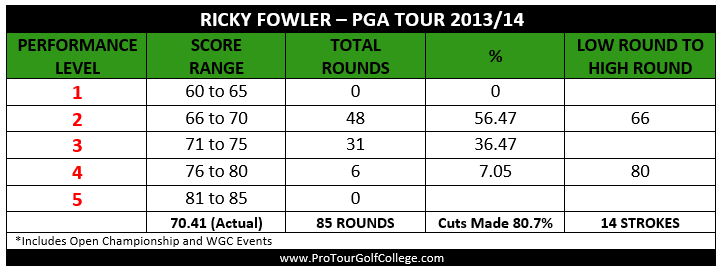"Maybe you feel you can justify your actions by saying to yourself, your friends and your family that you are going to tour school to “gain tour school experience.” If this is the case, then you will quickly discover that tour school is a very expensive form of experience to be had."  We speak to numerous golfers (and quite often their parents) via email, Skype, or face to face on a monthly basis about what the minimum requirements are for an amateur golfer to successfully make the transition to a professional golf tour through a tour school. As I’m sure you can imagine, there’s predominantly no shortage of male and female golfers very interested in this subject, and they are investing a great deal of effort in preparation to go to tour school, getting a card, to play on a professional golf tour. Maybe you are one of them? Now if you satisfy their very reasonable entry criteria (I have a lot more to say about this later on), tour schools will open their doors to you with welcoming arms, inviting you try out. But before you sign on the dotted line to commit yourself to the tour school process, there are some things--we call ‘Harsh Realities’ you absolutely must know about, before you invest the time, effort and money to take the plunge into professional golf via a tour school. The First Harsh Reality The first thing you must understand (and I do mean understand) is that being a top ranked amateur golfer in your region, or even at national level doesn’t guarantee much of anything when you go to tour school as there are literally hundreds and hundreds of amateurs (and professionals) also teeing it up who can play just as well as you, and some, much better. Where you might have been the big fish in your little pond in your home town, District, State or Province, now you will be a minnow competing in a massive ocean of golf talent. Now believe me when I say that this comes as a big shock to many amateurs when they realize that their game is nowhere near good enough to qualify--let alone compete on a professional golf tour.  The Second Harsh Reality Earlier I mentioned ‘reasonable entry criteria,’ and for many tours this means that if you possess a low handicap (under 2), or the equivalent playing standard, then you will be able enter tour school. Now here’s the thing you need to pay attention to regarding this. To get through any tour school it is very likely that you will have to produce a scoring average for the tournament of better than par over one or two golf courses that the tour uses for their tour school. Now if you enter the tour school with a handicap of scratch to 2 it is highly unlikely that you will earn your card as this standard of golf simply won’t be good enough. Now ask yourself why a professional golf tour would invite low handicap golfers to enter their event when they aren’t good enough to qualify?... Tour schools love rookie pro's who are of the mind-set; “I want to try tour school out to see if I’m good enough.” You NEVER ‘try’ tour school out! Golfers who are good enough to get through the tour school process and get their tour card, quickly realize that they are competing in pro events where the standard of competition is way better than what they have ever faced as an amateur, regardless of the tournaments level of importance. Tour schools want the best of the best, but having said that, if you are naive enough to enter a tour school with a golf game no where near good enough, then understand that you will simply be donating your hard earned cash (or someone else’s), to their cause. Maybe you feel you can justify your actions by saying to yourself, your friends and your family that you are going to tour school to “gain tour school experience.” If this is the case, then you will quickly discover that tour school is a very expensive form of experience to be had. The entry fee’s, the transport costs, meals, caddie fees, and accommodation costs to stay in a foreign location for at least 2 weeks add up. I guess the one consolation of this is that you will start to understand just a small part of what self-employed professional golfers know all too well, that being a professional tour golfer is an expensive exercise! At the end of the day all tour schools are nothing more than tour player boot camps that put you into a pressure cauldron with hundreds of other hopefuls, test your mental toughness and scoring ability, and squeeze out the survivors  Think of them like expensive turnstiles that let hundreds of hopefuls in, keep just a few, and let the rest exit out the other end—less your entry fees and associated costs. Tour schools are first and foremost a business, and the business community would describe them as ‘cash cows,’ which is business speak for a business that generates a consistent return of profits that far exceed the amount of cash required to start it. The tour schools know that when they market new tour school dates that literally hundreds of hopefuls will enter their school, and they receive a literal dump truck full of entry fees. However, since (in most cases) less than 5 percent of the of all the golfers competing will actually earn a card, the rest of the entry fee's is a windfall for them. The bottom 95 percent that don't get a card will go back home to their clubs with their tail between their legs trying to work out what went wrong, and what they need to do to get one of those tour cards next time. Many won’t ever go back.  The Third Harsh Reality OK so let’s assume that you were good enough to get a card to play on a pro tour. Congratulations! The challenge you now face is playing well enough in a limited number of events to finish high enough up the money list to keep your card for the next season--or in some cases to continue playing that season. Now this is not nearly as easy as it sounds, let me explain. You see depending on the tour you qualify on, as a rookie you will not be eligible to play in the biggest and most lucrative events on the tour, which basically means you sit out for one or more weeks at a time, with no events to compete in, until an event you are eligible to play in comes around. (*If you have a card on one of the major golf tours you can usually play on their secondary tour if an event coincides with the event you weren’t eligible to play in) So even though your tour might have an advertised schedule with 22 events, you might be only eligible to play in 15 of them. This means that you only get 15 chances to make enough income finishing high enough in the tournaments you can play in to keep your card. So let’s say for example that you need to earn a minimum of $150,000 for the season to keep your card for the next season. You will have just 15 chances to make the cut and play well enough over the final 2 days to earn a cheque that on average must add up to 10,000 dollars or more, to come back next season. Now how good do you think you would have to play in those 15 events? In other words, ask yourself what your round 3rd and 4th round scoring average would need to be to earn 10,000 dollars--15 times over the season? “It is an odd juxtaposition for a player to be rated in the top 500 golfers in the entire world (remember, that means he’s better than and ahead of millions and millions of others) and yet that is nowhere near good enough.” – Ross Biddiscombe (Author of Cruel School)  The Fourth Harsh Reality I looked up the progress of a very good young professional golfer in his mid-20’s who, as an amateur was the best golfer in his state, and was also one of the top 5 ranked amateurs in the country. This young man would score in the mid 60’s often in big amateur tournaments, and he even won a state level pro event over 4 rounds with a double digit 4 round total. Now as a professional he has gone through the process of making it onto one of the PGA Tour’s secondary tours, and nearly 4 years into his pro tour internship, his world ranking (at the time of writing) is 895, just 5 places lower than he was when he turned professional. Now, like I said, he is a really fine golfer, and can really play, and I’m sure he can go on to have a great career as a professional golfer, if he can make it through his pro tour internship. It just goes to show you that being a top gun amateur with a very low plus handicap (i.e. – 3 to – 6 against scratch) doesn’t guarantee much of anything in the pro game, except that you have more chance of making cuts and making cheques because of a proven low scoring ability in tournaments, than amateurs with low handicaps of scratch or above. So the big question you need to ask yourself is this; are you really (truly) good enough to go to tour school, or are you kidding yourself? However, don’t despair, it’s not all bad news. No one likes to waste their hard earned money, and yet many tour hopefuls are doing just that by investing in something they are just not ready for. So how do you know whether you are ready or not? So How Good Do You Really Have to Be? When you decide to go to a tour school, our advice is that your scoring average is at least 2 strokes better than par in top amateur tournaments over at least 2 seasons. You should be regularly scoring in the mid 60's and it should feel relatively easy to do. If you played 100 competitive rounds over 2 seasons as an amateur, here's the minimum performance level you would need to be able to achieve before you sign up to a tour school. Level 1) ...5 rounds would be 60 to 65 Level 2) ...55 rounds would be 66 to 70 Level 3) ...35 rounds would be 71 to 75 Level 4) ...5 rounds would be 76 to 80 Level 5) ...0 rounds would be above 80  More than 56% of Ricky Fowler's rounds were under 70 in 2013/14 More than 56% of Ricky Fowler's rounds were under 70 in 2013/14 At the very least, 50 percent of your competitive rounds would be under 70. You will also have scored under par over 3 to 4 rounds multiple times, and ideally you would have scored 10 under par or better at least once. This level of scoring should not come as a surprise to you if you simply study the results of professionals in tournaments from the minor tours to the major ones. To make cheques in professional tournaments, there are 2 stages.
This might look to you like it’s exaggerated, but it isn’t, it’s the reality of playing successfully as a professional golfer. Unless you can score like this, you simply won’t make cuts, and if you don’t make cuts--you don’t make cheques and if you don’t make cheques, your expenses will outweigh your income, and in no time at all, you will go broke! So take the time to set up a table like the one above, track every score in the tournaments you play in, fill in the blanks and see whether you really have enough game to go to tour school and get your card. We sure hope you do. Lawrie Montague and David Milne - Pro Tour Golf College Perth / Jakarta www.ProTourGolfCollege.com
Ronald
3/8/2016 09:16:43 pm
Great article. Really eye opening and gives me a better understanding of what scores I need to be shooting on average to be successful on a tour school
Harjot Singh
5/8/2016 10:46:59 am
A real eye opener. It is tougher than what people think to be able to earn out of pro golf. Comments are closed.
|
Archives
June 2019
|
Proudly Supported By
Copyright © 2011 - 2018 Pro Tour Golf College
Website Managed By Golf Performance Media
All Rights Reserved
Website Managed By Golf Performance Media
All Rights Reserved





 RSS Feed
RSS Feed



